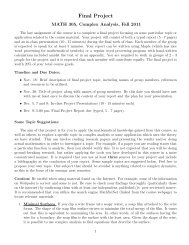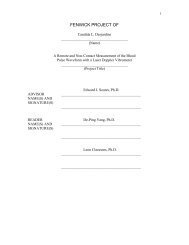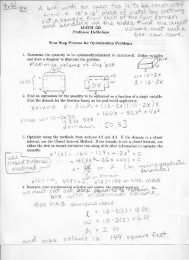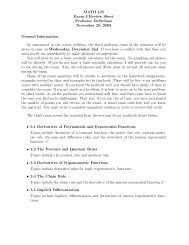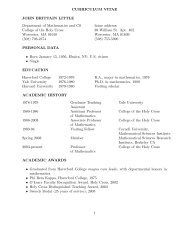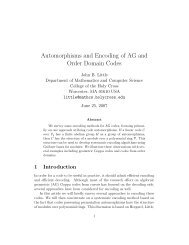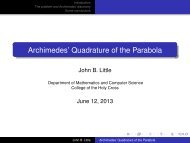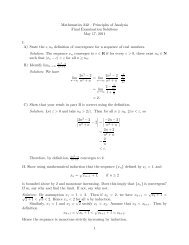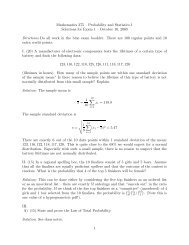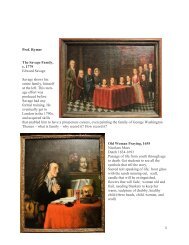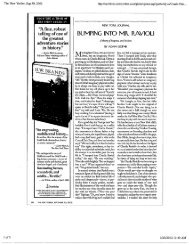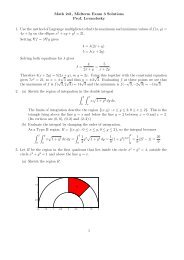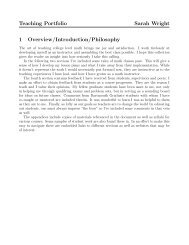Béla Bartók and the Golden Section - Mathematics and Computer ...
Béla Bartók and the Golden Section - Mathematics and Computer ...
Béla Bartók and the Golden Section - Mathematics and Computer ...
You also want an ePaper? Increase the reach of your titles
YUMPU automatically turns print PDFs into web optimized ePapers that Google loves.
<strong>Béla</strong> <strong>Bartók</strong> <strong>and</strong> <strong>the</strong> <strong>Golden</strong> <strong>Section</strong><br />
Gareth E. Roberts<br />
Department of Ma<strong>the</strong>matics <strong>and</strong> <strong>Computer</strong> Science<br />
College of <strong>the</strong> Holy Cross<br />
Worcester, MA<br />
Math/Music: Aes<strong>the</strong>tic Links<br />
Montserrat Seminar Spring 2012<br />
March 30 <strong>and</strong> April 2, 2012<br />
G. Roberts (Holy Cross) <strong>Béla</strong> <strong>Bartók</strong> Math/Music: Aes<strong>the</strong>tic Links 1 / 29
<strong>Béla</strong> <strong>Bartók</strong><br />
Born in Nagyszentmiklós Hungary (now Sînnicolau Mare,<br />
Romania) in 1881. Died in New York, Sept. 1945.<br />
Could play 40 songs on <strong>the</strong> piano by age 4. Writes first piece of<br />
music at age 6. Quickly becomes a chapel organist <strong>and</strong> an<br />
accomplished pianist <strong>and</strong> composer.<br />
Studies at <strong>the</strong> Catholic Gymnasium (high school) in Pozsony<br />
where he excels in math <strong>and</strong> physics in addition to music. Enters<br />
<strong>the</strong> Academy of Music (Liszt is 1st president) in Budapest in 1899.<br />
Avid collector of folk music (particularly Hungarian, Romanian,<br />
Slovakian <strong>and</strong> Turkish).<br />
Influenced by Debussy <strong>and</strong> Ravel; preferred Bach to Beethoven.<br />
Considered to be one of Hungary’s greatest composers (along<br />
with Franz Liszt).<br />
G. Roberts (Holy Cross) <strong>Béla</strong> <strong>Bartók</strong> Math/Music: Aes<strong>the</strong>tic Links 2 / 29
<strong>Béla</strong> <strong>Bartók</strong> (cont.)<br />
Figure: <strong>Bartók</strong> at age 22.<br />
Very interested in nature. Builds impressive collection of plants,<br />
insects <strong>and</strong> minerals. Fond of sunflowers <strong>and</strong> fir-cones.<br />
“We follow nature in composition ... folk music is a phenomenon of<br />
nature. Its formations developed as spontaneously as o<strong>the</strong>r living<br />
natural organisms: <strong>the</strong> flowers, animals, etc.” — <strong>Bartók</strong>, At <strong>the</strong><br />
Sources of Folk Music (1925)<br />
Notoriously silent about his own compositions. “Let my music<br />
speak for itself, I lay no claim to any explanation of my works!”<br />
G. Roberts (Holy Cross) <strong>Béla</strong> <strong>Bartók</strong> Math/Music: Aes<strong>the</strong>tic Links 3 / 29
Ernö Lendvai<br />
Beginning in 1955, <strong>the</strong> Hungarian musical analyst Ernö Lendvai<br />
starts to publish works claiming <strong>the</strong> existence of <strong>the</strong> Fibonacci<br />
numbers <strong>and</strong> <strong>the</strong> golden ratio in many of <strong>Bartók</strong>’s pieces.<br />
Some find Lendvai’s work fascinating <strong>and</strong> build from his initial<br />
ideas; o<strong>the</strong>rs find errors in his analysis <strong>and</strong> begin to discredit him.<br />
Lendvai becomes a controversial figure in <strong>the</strong> study of <strong>Bartók</strong>’s<br />
music.<br />
Lendvai draws connections between <strong>Bartók</strong>’s love of nature <strong>and</strong><br />
“organic” folk music, with his compositional traits. He takes a<br />
broad view, examining form (structure of pieces, where climaxes<br />
occur, phrasing, etc.) as well as tonality (modes <strong>and</strong> intervals), in<br />
discerning a substantial use of <strong>the</strong> golden ratio <strong>and</strong> <strong>the</strong> Fibonacci<br />
numbers.<br />
G. Roberts (Holy Cross) <strong>Béla</strong> <strong>Bartók</strong> Math/Music: Aes<strong>the</strong>tic Links 4 / 29
Example: Music for Strings, Percussion <strong>and</strong> Celesta, Movement I<br />
Lendvai’s analysis states:<br />
1 Piece is 89 measures long.<br />
2 The climax of <strong>the</strong> movement occurs at <strong>the</strong> end of bar 55 (loudest<br />
moment), which gives a subdivision of two Fibonacci numbers (34<br />
<strong>and</strong> 55) that are an excellent approximation to <strong>the</strong> golden ratio.<br />
3 Violin mutes begin to be removed in bar 34 <strong>and</strong> are placed back<br />
on in bar 69 (56 + 13 = 69).<br />
4 The exposition in <strong>the</strong> opening ends after 21 bars.<br />
G. Roberts (Holy Cross) <strong>Béla</strong> <strong>Bartók</strong> Math/Music: Aes<strong>the</strong>tic Links 5 / 29
Music for Strings, Percussion <strong>and</strong> Celesta (1936)<br />
G. Roberts (Holy Cross) <strong>Béla</strong> <strong>Bartók</strong> Math/Music: Aes<strong>the</strong>tic Links 6 / 29
G. Roberts (Holy Cross) <strong>Béla</strong> <strong>Bartók</strong> Math/Music: Aes<strong>the</strong>tic Links 7 / 29
G. Roberts (Holy Cross) <strong>Béla</strong> <strong>Bartók</strong> Math/Music: Aes<strong>the</strong>tic Links 8 / 29
G. Roberts (Holy Cross) <strong>Béla</strong> <strong>Bartók</strong> Math/Music: Aes<strong>the</strong>tic Links 9 / 29
G. Roberts (Holy Cross) <strong>Béla</strong> <strong>Bartók</strong> Math/Music: Aes<strong>the</strong>tic Links 10 / 29
G. Roberts (Holy Cross) <strong>Béla</strong> <strong>Bartók</strong> Math/Music: Aes<strong>the</strong>tic Links 11 / 29
G. Roberts (Holy Cross) <strong>Béla</strong> <strong>Bartók</strong> Math/Music: Aes<strong>the</strong>tic Links 12 / 29
G. Roberts (Holy Cross) <strong>Béla</strong> <strong>Bartók</strong> Math/Music: Aes<strong>the</strong>tic Links 13 / 29
G. Roberts (Holy Cross) <strong>Béla</strong> <strong>Bartók</strong> Math/Music: Aes<strong>the</strong>tic Links 14 / 29
G. Roberts (Holy Cross) <strong>Béla</strong> <strong>Bartók</strong> Math/Music: Aes<strong>the</strong>tic Links 15 / 29
G. Roberts (Holy Cross) <strong>Béla</strong> <strong>Bartók</strong> Math/Music: Aes<strong>the</strong>tic Links 16 / 29
Problems with Lendvai’s Analysis (Roy Howat)<br />
1 The piece is 88 bars long, not 89! Lendvai includes a footnote:<br />
“The 88 bars of <strong>the</strong> score must be completed by a whole-bar rest,<br />
in accordance with <strong>the</strong> Bülow analyses of Beethoven.” Hanh?!<br />
2 The dynamic climax of <strong>the</strong> piece is certainly at <strong>the</strong> end of bar 55.<br />
But <strong>the</strong> tonal climax is really at bar 44, when <strong>the</strong> subject returns a<br />
tritone away from <strong>the</strong> opening A to E♭. (88/2 = 44, symmetry?)<br />
3 The viola mutes come off at <strong>the</strong> end of bar 33 (not 34). The violin<br />
mutes are placed back on at <strong>the</strong> end of bar 68 (not 69). This last<br />
fact actually helps <strong>the</strong> analysis since 68 = 55 + 13, giving <strong>the</strong><br />
second part of <strong>the</strong> movement a division of 13 <strong>and</strong> 20 (21 if you<br />
allow <strong>the</strong> full measure rest at <strong>the</strong> end).<br />
4 The fugal exposition actually ends in bar 20, not 21.<br />
5 What about <strong>the</strong> celesta? It enters after bar 77. 77 − 55 = 22<br />
(close to Fibonacci). Lendvai neglects to mention this key feature.<br />
G. Roberts (Holy Cross) <strong>Béla</strong> <strong>Bartók</strong> Math/Music: Aes<strong>the</strong>tic Links 17 / 29
proportionally presence 1 missing quaver<br />
bar 88:<br />
Fig. 4: Fugue from Music for Strings, Percussion <strong>and</strong> Celeste<br />
PP fff PPP<br />
55<br />
21 3468 81 89<br />
(a) _ _<br />
ideal proportions<br />
claimed by Lendvai<br />
21 13 21 13 .... 13 8<br />
(b) 20 13 22 13 9 4 7<br />
actual<br />
proportions<br />
20 33 68 88<br />
mutes off: mutes end<br />
episode Bb timpani replaced 77<br />
pedal 55 celeste<br />
climax<br />
(coda)<br />
!<br />
Figure: Fennelly Roy Howat’s (1973) <strong>and</strong> analysis Kramer of(1973) Lendvai’s also identify work, from <strong>the</strong>se “<strong>Bartók</strong>, discrepancies, Lendvai <strong>and</strong> <strong>and</strong> Fennelly<br />
<strong>the</strong> Principles<br />
notes <strong>the</strong> opening of Proportional<br />
four-bar<br />
Analysis,” sequences of<br />
Music<br />
<strong>the</strong> Fugue. Analysis,<br />
Kramer<br />
2, No.<br />
concludes<br />
1 (March,<br />
that <strong>the</strong><br />
Fugue's proportional tendencies are <strong>the</strong>refore 'a less significant structural force than<br />
1983), in o<strong>the</strong>r pp. 69-95. works . . .' (1973:120). Yet, as with <strong>the</strong> scheme seen in Fig. 3 above, <strong>the</strong><br />
clarity <strong>and</strong> force of this overall shape suggest <strong>the</strong> opposite, despite <strong>the</strong> inaccuracies.<br />
Why <strong>the</strong> inaccuracies, <strong>the</strong>n?<br />
G. Roberts Two alternative (Holy Cross) methods of counting <strong>Béla</strong> <strong>Bartók</strong> can be considered. Math/Music: First, because Aes<strong>the</strong>tic Links bar lengths 18 / 29
Key Features of Movement I<br />
The piece is a fugue (think Bach) with <strong>the</strong> opening subject played<br />
by <strong>the</strong> viola starting on A. This chromatic <strong>the</strong>me only ranges a<br />
tritone in distance (6 halfsteps) to E♭.<br />
The successive entrances of <strong>the</strong> main <strong>the</strong>me alternate between<br />
ascending perfect 5ths (A → E → B → F♯ etc.) <strong>and</strong> descending<br />
perfect 5ths (A → D → G → C etc.). This serves to keep each<br />
subject musically “close,” as demonstrated by <strong>the</strong> circle of fifths.<br />
The <strong>the</strong>mes come back to <strong>the</strong> same note a tritone away, on E♭ at<br />
<strong>the</strong> tonal climax of <strong>the</strong> movement (bar 44), exactly half way<br />
through <strong>the</strong> piece.<br />
In <strong>the</strong> second half of <strong>the</strong> piece (after <strong>the</strong> dynamic climax), <strong>the</strong><br />
subject is inverted (exactly) <strong>and</strong> moves back around <strong>the</strong> circle of<br />
fifths to return to <strong>the</strong> opening A. Often, only <strong>the</strong> opening 5 notes<br />
are used (e.g., measure 65). The original 5-note opening of <strong>the</strong><br />
subject returns in measure 82, dividing <strong>the</strong> coda (defined by <strong>the</strong><br />
entrance of <strong>the</strong> celesta) into 4 + 7 bars.<br />
G. Roberts (Holy Cross) <strong>Béla</strong> <strong>Bartók</strong> Math/Music: Aes<strong>the</strong>tic Links 19 / 29
Key Features of Movement I (cont.)<br />
The opening four bars (where <strong>the</strong> main <strong>the</strong>me is announced) are<br />
subdivided into 3’s <strong>and</strong> 2’s. For example, 3 + 3 + 2 in measure 1<br />
<strong>and</strong> 3 + 3 + 3 + 3 in measure 2.<br />
The first stretto in <strong>the</strong> Fugue (where <strong>the</strong> initial subject is<br />
interrupted by ano<strong>the</strong>r entrance of <strong>the</strong> subject before completing),<br />
occurs just before <strong>the</strong> end of measure 26 on <strong>the</strong> pitches F♯ (1st)<br />
<strong>and</strong> <strong>the</strong>n C (2nd). These are precisely 1/2 way around <strong>the</strong> circle of<br />
fifths. These return in inversion in <strong>the</strong> second half of <strong>the</strong><br />
movement, ending in measure 68, giving a golden section split of<br />
42 : 26.<br />
A very noticeable exact inversion of <strong>the</strong> <strong>the</strong>me occurs over <strong>the</strong> last<br />
three measures between <strong>the</strong> first <strong>and</strong> second violins. This<br />
inversion is about A, reaffirming it as <strong>the</strong> tonal center of <strong>the</strong><br />
movement. The inversion rises <strong>and</strong> falls a tritone to E♭ in both<br />
voices, mimicking <strong>the</strong> overall harmonic structure of <strong>the</strong> piece.<br />
G. Roberts (Holy Cross) <strong>Béla</strong> <strong>Bartók</strong> Math/Music: Aes<strong>the</strong>tic Links 20 / 29
!<br />
!<br />
Fig. 5: Fugue from Music for Strings, Percussion <strong>and</strong> Celeste<br />
dynamic arch<br />
tonal symmetries<br />
PP fff PPP<br />
20<br />
first<br />
episode<br />
33<br />
mutes<br />
off<br />
55<br />
climax 68<br />
mutes<br />
on<br />
88<br />
end<br />
13 20<br />
44<br />
subject reaches<br />
Eb<br />
4 44 - - 44 -<br />
77<br />
coda<br />
S11 11 11<br />
7 11 7 4<br />
interactions I 11-<br />
18 II I<br />
4 4 4 414 4 4<br />
opening sequence<br />
20 44 55<br />
0 I Eb fff<br />
6<br />
melodic peak<br />
(2nd vlns)<br />
20 31<br />
II<br />
melodic peak<br />
mo p<br />
1<br />
26 42<br />
o<strong>the</strong>r<br />
connections C26 I<br />
en68 of<br />
I<br />
I<br />
I<br />
C/F•: end of<br />
stretto inverted<br />
C/F? stretto<br />
30 47<br />
7 4<br />
7 4<br />
30 77<br />
end of coda begins<br />
exposition<br />
G. Roberts (Holy Cross) <strong>Béla</strong> <strong>Bartók</strong> Math/Music: Aes<strong>the</strong>tic Links 21 / 29<br />
!
Fig 7: third movement of Music for Strings, Percussion <strong>and</strong> Celeste<br />
/<br />
34<br />
60'/48\ \<br />
A Alle rtto<br />
E<br />
~ climax-<br />
/inversion<br />
/ \/<br />
I<br />
I<br />
--<br />
20?%-<br />
48 269? /<br />
I I 1'<br />
I I I I<br />
segments of AB. C A'<br />
arch form<br />
I---_ 2 -I<br />
!<br />
!<br />
! <strong>the</strong> logarithmic spiral (1971:31) <strong>and</strong> suggests that its cross-section corresponds closely<br />
to <strong>the</strong> structures seen above in Figs 3a <strong>and</strong> 4a. In fact it fits nei<strong>the</strong>r of <strong>the</strong>m well since<br />
<strong>the</strong>y are too symmetrical, but it very aptly matches <strong>the</strong> form <strong>and</strong> dynamic shape of <strong>the</strong><br />
third movement of <strong>the</strong> Music for Strings (again allowing for <strong>the</strong> approximations),<br />
centering on <strong>the</strong> climax as shown in Fig. 7. In <strong>the</strong> process it shows a possible<br />
explanation of why <strong>the</strong> two outermost transitions in <strong>the</strong> form - those uninvolved in<br />
<strong>the</strong> spiral - are 1, <strong>the</strong> 1, most 2, masked 3, <strong>and</strong> 5, ambiguous. 8, 5, 3, 2, 1, 1<br />
Because musical form cannot literally follow <strong>the</strong> spiral shape, this aspect of <strong>the</strong><br />
analysis is inevitably hypo<strong>the</strong>tical. We can only guess that Bart6k may have intended<br />
<strong>the</strong> spiral to be symbolic, <strong>and</strong> <strong>the</strong>re is some circumstantial evidence of Bart6k's<br />
interest in this shape as potentially musical: in 1909 he wrote out a copy of 'Seesaw'<br />
(Seven Sketches, Op. 9b, No. 2) literally in spiral form (see <strong>the</strong> facsimile in Bart6k<br />
1981, Series 1: Introduction).<br />
Close analysis could also throw light on o<strong>the</strong>r golden section occurrences found by<br />
George Perle in Bart6k's Fourth Quartet (reported by Antokoletz 1975: 146-50) <strong>and</strong><br />
G. Roberts (Holy Cross) Fifth <strong>Béla</strong> <strong>Bartók</strong> Math/Music: Aes<strong>the</strong>tic Links 22 / 29<br />
Quartet (Perle The most is<br />
The opening xylophone solo in <strong>the</strong> third movement has <strong>the</strong> rhythmic<br />
pattern of<br />
with a crescendo followed by a decrescendo (hairpin) climaxing at <strong>the</strong><br />
top of <strong>the</strong> sequence. Obvious nod to Fibonacci.
!<br />
Ex. 2: Facsimile of recto pages 1 <strong>and</strong> 2 from manuscript 80FSS1 in <strong>the</strong> New York<br />
B61a Bart6k Archive, reproduced by kind permission of Dr Benjamin<br />
Suchoff, Trustee of <strong>the</strong> Bart6k Estate.<br />
of K ?/-/<br />
+P<br />
~~?i~4it ji<br />
_ g3<br />
\<br />
//<br />
f.( Jb2<br />
since in this example <strong>the</strong> calculations are written on a separate sheet from <strong>the</strong> music.<br />
One might still argue that Bart6k was unaware of <strong>the</strong> significance of <strong>the</strong> numbering<br />
here. In that case <strong>the</strong> same would have to apply to many o<strong>the</strong>r obvious or fundamental<br />
relationships: <strong>the</strong> 1-2-3-5-8-5-3-2-1 sequence of <strong>the</strong> xylophone solo already mentioned<br />
in <strong>the</strong> Music for Strings; some of <strong>the</strong> 'Bulgarian' metres in pieces such as <strong>the</strong><br />
Figure: If you dig deep enough ... <strong>Bartók</strong>’s analysis of a Turkish folk song<br />
showing <strong>the</strong> Lucas numbers.<br />
86<br />
IA -<br />
MUSIC ANALYSIS 2:1, 1983<br />
G. Roberts (Holy Cross) <strong>Béla</strong> <strong>Bartók</strong> Math/Music: Aes<strong>the</strong>tic Links 23 / 29<br />
!
O<strong>the</strong>r Composers’ Influence on <strong>Bartók</strong><br />
Zoltán Kodály (1882-1967): Hungarian composer, collector of folk<br />
music, interested in music education (“Kodály Method”).<br />
Kodály befriends <strong>Bartók</strong> around 1905-1906. They bond over <strong>the</strong>ir<br />
mutual interest in folk music (Kodály was collecting phonograph<br />
cylinders of folk music in <strong>the</strong> remote areas of Hungary).<br />
In 1907, Kodály writes Méditation sur un motif de Claude<br />
Debussy. Just as with <strong>the</strong> fugue from <strong>Bartók</strong>’s Music for Strings,<br />
Percussion <strong>and</strong> Celesta, <strong>the</strong> piece opens pp <strong>and</strong> ends ppp, with a<br />
central climax marked fff. If one counts quarter notes ra<strong>the</strong>r than<br />
measures, <strong>the</strong>re are 508 beats. The golden ratio of 508 is 314 (to<br />
<strong>the</strong> nearest integer) <strong>and</strong> this just happens to be smack in <strong>the</strong><br />
middle of <strong>the</strong> two climatic bars at fff.<br />
G. Roberts (Holy Cross) <strong>Béla</strong> <strong>Bartók</strong> Math/Music: Aes<strong>the</strong>tic Links 24 / 29
Claude Debussy (1862-1918)<br />
As Kodály was bringing Debussy to <strong>Bartók</strong>’s attention, Debussy<br />
composes some interesting piano pieces whose form<br />
demonstrates <strong>the</strong> golden ratio.<br />
Images, published in 1905, consists of three piano pieces: Reflets<br />
dans l’eau, Mouvement <strong>and</strong> Hommage à Rameau. These soon<br />
became part of <strong>Bartók</strong>’s piano repertoire.<br />
Reflets <strong>and</strong> Mouvement begin pp <strong>and</strong> finish ppp or pp,<br />
respectively. They also have main climaxes at ff <strong>and</strong> fff,<br />
respectively, located at places that divide <strong>the</strong> total piece into two<br />
portions in <strong>the</strong> golden ratio.<br />
Hommage à Rameau has a similar structure dynamically <strong>and</strong>,<br />
according to Roy Howat’s analysis, “is built very clearly on<br />
Fibonacci numbers.”<br />
G. Roberts (Holy Cross) <strong>Béla</strong> <strong>Bartók</strong> Math/Music: Aes<strong>the</strong>tic Links 25 / 29
Reflets dans l’eau, Debussy<br />
Analysis given by Roy Howat in Debussy in proportion: A musical<br />
analysis, Cambridge University Press, 1983.<br />
G. Roberts (Holy Cross) <strong>Béla</strong> <strong>Bartók</strong> Math/Music: Aes<strong>the</strong>tic Links 26 / 29
Reflets dans l’eau, Tonal Structure<br />
G. Roberts (Holy Cross) <strong>Béla</strong> <strong>Bartók</strong> Math/Music: Aes<strong>the</strong>tic Links 27 / 29
Hommage à Rameau, Debussy<br />
G. Roberts (Holy Cross) <strong>Béla</strong> <strong>Bartók</strong> Math/Music: Aes<strong>the</strong>tic Links 28 / 29
Final Remarks<br />
Lendvai’s inaccuracies partly due to a narrow focus on <strong>the</strong><br />
Fibonacci numbers. It’s clear that <strong>the</strong> Lucas numbers were more<br />
significant in <strong>the</strong> first movement of Music for Strings, Percussion<br />
<strong>and</strong> Celesta.<br />
O<strong>the</strong>r works by <strong>Bartók</strong> where <strong>the</strong> golden ratio can be detected are<br />
Sonata for Two Pianos <strong>and</strong> Percussion, Miraculous M<strong>and</strong>arin, <strong>and</strong><br />
Divertimento.<br />
<strong>Bartók</strong> was highly secretive about his works. Surviving<br />
manuscripts of many of <strong>the</strong> pieces where <strong>the</strong> golden ratio appears<br />
to have been used contain no mention of it.<br />
<strong>Bartók</strong> was already being criticized for being too “cerebral” in his<br />
music. Identifying <strong>the</strong> ma<strong>the</strong>matical patterns in structure <strong>and</strong><br />
tonality (even to his students!) would have only added fuel to <strong>the</strong><br />
fire.<br />
G. Roberts (Holy Cross) <strong>Béla</strong> <strong>Bartók</strong> Math/Music: Aes<strong>the</strong>tic Links 29 / 29



